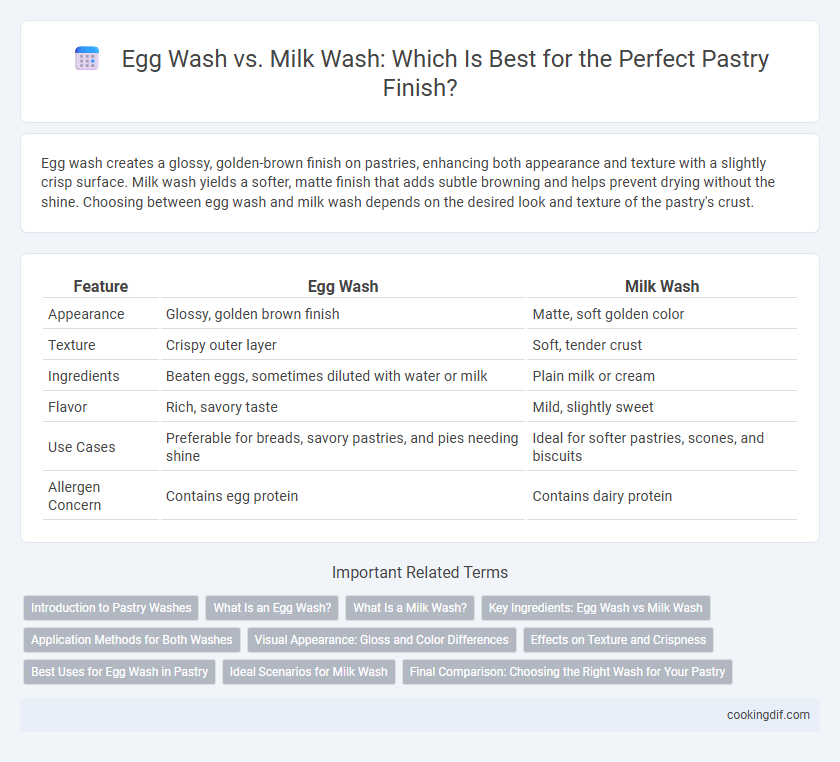Egg wash creates a glossy, golden-brown finish on pastries, enhancing both appearance and texture with a slightly crisp surface. Milk wash yields a softer, matte finish that adds subtle browning and helps prevent drying without the shine. Choosing between egg wash and milk wash depends on the desired look and texture of the pastry's crust.
Table of Comparison
| Feature | Egg Wash | Milk Wash |
|---|---|---|
| Appearance | Glossy, golden brown finish | Matte, soft golden color |
| Texture | Crispy outer layer | Soft, tender crust |
| Ingredients | Beaten eggs, sometimes diluted with water or milk | Plain milk or cream |
| Flavor | Rich, savory taste | Mild, slightly sweet |
| Use Cases | Preferable for breads, savory pastries, and pies needing shine | Ideal for softer pastries, scones, and biscuits |
| Allergen Concern | Contains egg protein | Contains dairy protein |
Introduction to Pastry Washes
Pastry washes like egg wash and milk wash are essential for achieving a golden, glossy finish on baked goods. Egg wash, made from beaten eggs sometimes mixed with water or milk, provides a shiny, rich color and helps toppings adhere. Milk wash offers a softer sheen and a tender crust, contributing to a milder appearance and subtle browning in pastries.
What Is an Egg Wash?
An egg wash is a mixture of beaten eggs, often combined with water or milk, applied to pastry surfaces before baking to create a glossy, golden-brown finish. This technique enhances the appearance and texture by promoting browning and adding a slight crispness. Egg wash is preferred over milk wash when a richer color and shine are desired on baked goods.
What Is a Milk Wash?
A milk wash is a pastry finishing technique where milk is brushed onto dough before baking to create a soft, golden-brown crust with a subtle sheen. Unlike an egg wash, which produces a glossy and often more intense color, a milk wash delivers a more matte finish while enhancing browning through the natural sugars and proteins in milk. This method is ideal for pastries requiring a tender, slightly sweet exterior without the strong shine of egg wash.
Key Ingredients: Egg Wash vs Milk Wash
Egg wash, made primarily from beaten eggs sometimes mixed with water or milk, provides pastries with a rich, glossy, and golden-brown finish due to its high protein and fat content that enhances browning through the Maillard reaction. Milk wash, typically consisting of whole milk or cream, offers a softer sheen and lighter color, adding slight richness and subtle browning from lactose and proteins but less intense than egg wash. Choosing between egg wash and milk wash depends on the desired pastry appearance and texture, with egg wash favored for a shiny, crispy crust and milk wash preferred for a gentler, matte finish.
Application Methods for Both Washes
Egg wash, typically made from beaten eggs or egg yolks mixed with water or milk, is applied using a pastry brush to create a glossy, golden-brown finish and a slightly crisp texture on pastries. Milk wash, consisting of milk or cream applied similarly, produces a softer, less shiny surface with subtle browning, ideal for a more matte appearance. Both washes require even brushing before baking to enhance color and texture without pooling or burning on the pastry surface.
Visual Appearance: Gloss and Color Differences
Egg wash creates a shiny, golden-brown finish on pastries due to its protein and fat content, enhancing visual appeal with a rich, glossy surface. Milk wash imparts a softer, matte sheen with a lighter, yellowish-brown color, providing a subtler, more natural look. The choice between egg and milk wash directly impacts the final gloss intensity and color warmth of baked goods.
Effects on Texture and Crispness
Egg wash creates a glossy, golden-brown finish on pastries and enhances crispness by promoting Maillard reaction during baking. Milk wash results in a softer, matte crust with a slightly tender texture due to its higher sugar and fat content. Choosing egg wash intensifies texture contrast, while milk wash provides a more subtle, delicate crust.
Best Uses for Egg Wash in Pastry
Egg wash, made from beaten eggs often mixed with water or milk, creates a shiny, golden-brown crust ideal for puff pastries, croissants, and pie crusts. Its protein content promotes browning and adds a slight crispness, enhancing the visual appeal and texture of baked goods. Egg wash is best used on pastries that benefit from a rich, glossy finish and a firm surface, such as Danish pastries and empanadas.
Ideal Scenarios for Milk Wash
Milk wash creates a soft, golden-brown finish ideal for pastries like soft rolls, muffins, and scones, enhancing tenderness and moisture retention. It is preferred when a subtle sheen and delicate crust are desired, avoiding the glossy or firm texture produced by egg wash. Milk wash works well for dairy-based pastries or those topped with sugar, as it promotes gentle browning without altering flavor or texture significantly.
Final Comparison: Choosing the Right Wash for Your Pastry
Egg wash provides a glossy, deep golden-brown finish and enhances browning due to its protein and fat content, making it ideal for a rich, visually appealing crust. Milk wash yields a softer sheen with a lighter color and adds subtle moisture, perfect for tender, less shiny pastries. Selecting between egg wash and milk wash depends on the desired texture, color intensity, and overall appearance of the pastry.
Egg wash vs Milk wash for pastry finish Infographic

 cookingdif.com
cookingdif.com